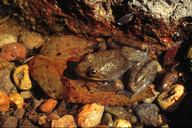|
Rana tarahumarae Boulenger, 1917
Tarahumara Frog Subgenus: Zweifelia | family: Ranidae genus: Rana |
|
Taxonomic Notes: This species was placed in the genus Lithobates by Frost et al. (2006). However, Yuan et al. (2016, Systematic Biology, doi: 10.1093/sysbio/syw055) showed that this action created problems of paraphyly in other genera. Yuan et al. (2016) recognized subgenera within Rana for the major traditional species groups, with Lithobates used as the subgenus for the Rana palmipes group. AmphibiaWeb recommends the optional use of these subgenera to refer to these major species groups, with names written as Rana (Aquarana) catesbeiana, for example. |
|
 © 1992 Brad Moon (1 of 5) |
|
|
|
Description Distribution and Habitat Country distribution from AmphibiaWeb's database: Mexico, United States U.S. state distribution from AmphibiaWeb's database: Arizona
The habitat of R. tarahumarae includes canyon streams, some of which may only hold water in small, isolated pools in the dry season. The species is associated with oak woodland, tropical deciduous forest and pine forest vegetation, and occurs only between 1500 and 6000 feet. Life History, Abundance, Activity, and Special Behaviors
References
Zweifel, R. G. (1963). ''Rana tarahumarae (Boulenger). Tarahumara Frog.'' Catalogue of American Amphibians and Reptiles. American Society of Ichthyologists and Herpetologists, 66.1-66.2. Originally submitted by: Franziska Sandmeier (first posted 2001-02-23) Species Account Citation: AmphibiaWeb 2001 Rana tarahumarae: Tarahumara Frog <https://amphibiaweb.org/species/5165> University of California, Berkeley, CA, USA. Accessed May 21, 2025.
Feedback or comments about this page.
Citation: AmphibiaWeb. 2025. <https://amphibiaweb.org> University of California, Berkeley, CA, USA. Accessed 21 May 2025. AmphibiaWeb's policy on data use. |




 Map of Life
Map of Life